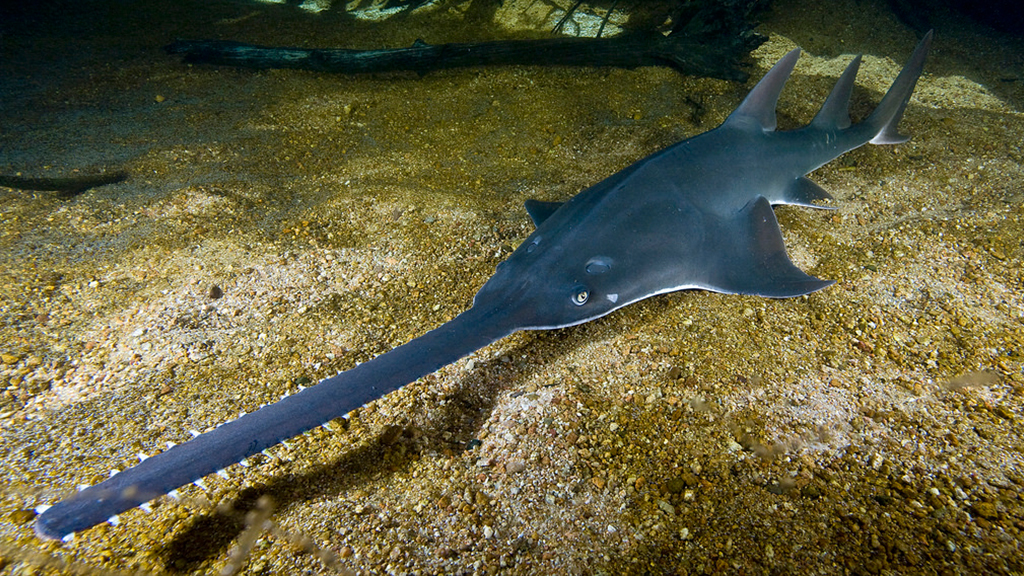5 Things You Didn’t Know About Sawfish
Sawfish are some of the most endangered ocean animals in the world

Recently, on a trip to the National Aquarium in Baltimore, Maryland, I had the good fortune of watching sawfish swim around in the tank. They look prehistoric and also otherworldly. I couldn’t stop wondering how they manage to swim so gracefully with a giant saw for a nose. If I were a sawfish, I would constantly be swimming into other fish and grounding my saw into the seabed. Watching the sawfish in the aquarium also made me sad—as it houses some of the most endangered ocean animals in the world, the aquarium is one of the last places we will be able to catch a glimpse of them.
Today, we are going to explore five things you didn’t know about sawfish. Put on your snorkel and dive in with us…
Sawfish are related to sharks
A sawfish swims into Home Depot—whom do they see in the aisle? A hammerhead shark, of course! In the toolbox of ocean animals, sawfish and hammerhead sharks are indeed related.
All sawfish are elasmobranchs. This group of fish includes rays, skates and sharks. Elasmobranchs do not have bones and instead have cartilage skeletal systems. Sawfish have a long, flat nose with teeth on each side, just like a saw. This distinctive nose, called a rostrum, is used to slice their prey and scavenge in the sand. Sawfish are similar in body shape to sharks but are actually a type of ray, with their gills and mouths on the underside of their bodies. Sawfish are BIG and can grow to almost 25 feet in length.
There are five species of sawfish
There are five recognized species of sawfish living worldwide today.
- Largetooth sawfish (Pristis pristis) used to have the largest range of all sawfish species, but their populations have declined worldwide due to overfishing and incidental catch. Largetooth sawfish are one of two sawfish species that have historically inhabited U.S. waters but haven’t been spotted here in more than 50 years.
- Dwarf sawfish (Pristis clavate) live off the coast of Australia and are the smallest of the sawfish species—growing no more than 10 feet in length.
- Smalltooth sawfish (Pristis pectinata) used to live in the western Atlantic Ocean from North Carolina to central Brazil, including the Gulf of Mexico, and the eastern Atlantic along the central west coast of Africa. Now, the smalltooth can be found only in south Florida.
- Green sawfish (Pristis zijsron) have the longest rostrum of any modern species of sawfish. Their skin is green and the species is also known as olive sawfish or longcomb sawfish.
- Narrow sawfish (Anoxypristis cuspidata) live in the Western Indo-Pacific from China and South Korea to the central coasts of western and eastern Australia. The narrow sawfish is also called knifetooth or pointed sawfish.
Sawfish can live in saltwater, brackish water and freshwater! They have been known to travel up river systems and even live in fresh water bays and coastal marine habitats. Sometimes, older sawfish have been seen swimming in deeper ocean waters.
Sawfish have a sixth sense
The distinctive nose of the sawfish—the rostrum—is covered in sensory organs called ampullae of Lorenzini that allow the sawfish to detect the movement of other fish in the water through electroreception. The rostrum has small pores (sensory organs) that can detect electric fields produced by prey.
Once detected, sawfish enjoy eating fish and crustaceans and use their rostrums to dig them up out of the sand or as weapons to knock them out. Sawfish can also use their rostrums to trap prey against the ocean floor. Electroreceptors are common to sharks and rays alike.
All sawfish are endangered
All species of sawfish are either endangered or critically endangered.
Sawfish are among the most endangered marine animals in the world—there are very few of them left in the ocean. Their populations have drastically declined because of overfishing, habitat loss and entanglement in marine debris.
Ocean Conservancy submitted the petition that led to the listing of smalltooth sawfish under the U.S. Endangered Species Act (ESA) in 2003. Since then, there have been exciting research findings and encouraging signs that this population may well be increasing.
Sawfish can reproduce without sex
In a stunning display of trying to make sure this species does NOT go extinct, the sawfish have found a way to reproduce without sex—which is great for a species where there are so few left swimming wild. The process of virgin births, called parthenogenesis, is seen in insects, arthropods, some birds, amphibians and fish in captivity. This is the first time such virgin births have been demonstrated in a vertebrate—an animal bearing a backbone—in the wild. The authors of the study hypothesized that “such virgin births may be more common in small or declining populations because males and females fail to find one another when it’s time to mate and then some of female’s eggs develop without sperm.”
Sawfish need our help
For more than 25 years, Ocean Conservancy has worked to find practical solutions to the challenging problems facing our fisheries. We’ve made real progress toward ending overfishing in U.S. waters and rebuilding fish populations—but, we still have a long way to go. We can’t achieve our goal of healthy fish populations for future generations without your commitment. Donate to Ocean Conservancy today and make a difference for the future of our ocean!